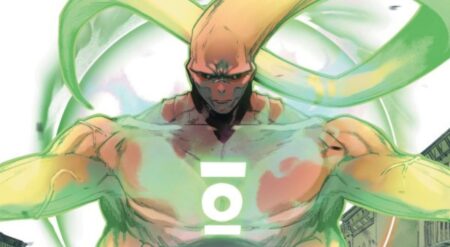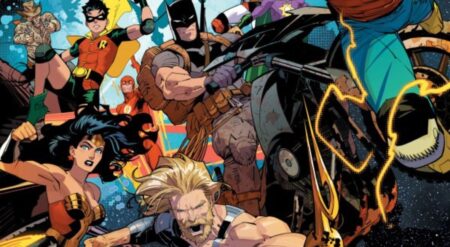Knight Terrors: Harley Quinn #2 is published by DC Comics, written by Tini Howard, art by Hayden Sherman, colors by Triona Farrell, and letters by Steve Wands. There is a backup story titled ‘Presque Vue,’ written by Leah Williams, art by PJ Holden, colors by Lee Loughridge, and letters by Hassan Otsmane-Helhaou. This is part of the Knight Terrors event. Harley Quinn is trapped exploring the Multiverse after she has already been given a warning about the consequences.
This is a strange issue, as it feels connected to everything but also vastly disconnected. It’s a selection of dreams within a dream, as alternate realities are displayed to Harley. But even this one last alternate world that Harley is exposed to lacks a sense of urgency. The idea is brilliant, presenting Harley as a classic A-list superhero, something that becomes a prominent theme of the tie-in. Harley doesn’t like the pressure of being a hero, preferring the freedom that comes with flying solo and under the radar. But it is also running parallel with Harley’s series, where she is on incredibly thin ice with messing with the Multiverse, which works when it comes to the manipulation of Insomnia. It isn’t easy to know what is real for Harley and even for those reading, as the levels of the twisting dimensions get more intense. There were many times when I found myself unable to stay focused on the story as I found the pacing too disjointed and the plot unable to find itself again. The ending makes everything circle back and is certainly different from the other Knight Terrors books, giving Harley an escape that heroes elsewhere haven’t had available to them.
The dialogue has some absolutely golden moments as Harley’s awareness is separate from other heroes and villains trapped in slumber. The introduction of comics in this meta-story has allowed Harley to reach the pinnacle of amazing, world-breaking jokes. She becomes aware of plotlines and storytelling devices, commenting on them. Things like the thought bubbles become a point of her commentary. She understands the Multiverse, but she just cannot find clarity on whether or not these excursions are real. And the comic isn’t just silly, acerbic fun. There is emotion and vulnerability within Harley’s dialogue. It doesn’t only revolve around Ivy, either. I found the exploration of Harley’s thoughts around the Justice League and the larger superheroes fascinating. But when the comic loses its steam, the dialogue does not have the energy in the later stages of Knight Terrors: Harley Quinn #2 to keep me hanging on every word.
The art is also mesmerizing as it features so many changes. In the base story, with Harley in her control room, her face is awkward and strange. The proportions look odd from certain angles, making them look twisted and contorted. But this is not the case during the alternate reality adventure. The classic style replicates that of DC Comics in their infancy when Flash and the other Silver Age characters were established. The 50’s inspired outfits and hairstyles seem to suit Harley and Sherman better, although the angle problem persists at times. The costume Harley wears in this tale has a simple brilliance, and the villain Harley faces is designed terrifically. But the city she protects in this “timeline” lacks character or any detail. The last location that Harley is taken to is huge and majestic, easily the best layout that Sherman provides in this tie-in.
The colors are bright and distinctive, with a clever technique brought in during the bulk of the issue. There is a polka dot texture across the whole page, from the buildings to the sky to Harley’s skin. The whole part of the page that is smooth is the red and black of Harley’s costume. This creates a superb definition and blurs the rest of the world around Harley, implying the dream world. The lettering is fantastic as Harley acknowledges and interacts with it, causing Wands to adjust the balloons to assist in the storytelling.
The backup story is truly bizarre. Harley and an older version of Harley are on a mysterious ship that may be their share consciousness. This ship is like an imposing, claustrophobic cave system, while both Harley’s talk about time and futility, as well s the vast emptiness of the universe. It’s a strange story that is difficult to comprehend and feels out of place at the end of this issue.
Knight Terrors: Harley Quinn #2 feels empty. The idea was great, and there are some really interesting pieces of dialogue. It takes the current event and matches it to what happened in Harley’s life, making it feel important and not just a side story. But the book makes the Multiverse jumping concept dull, with art that isn’t impressive enough to captivate or create new worlds that you want to explore further.
Knight Terrors: Harley Quinn #2 is available now wherever comics are sold.
Knight Terrors: Harley Quinn #2
TL;DR
Knight Terrors: Harley Quinn #2 feels empty. The idea was great, and there are some really interesting pieces of dialogue.







